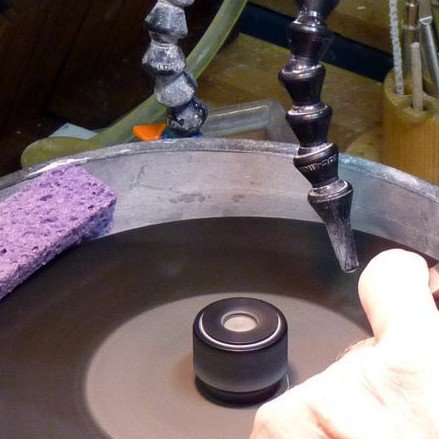Lapidary art is a centuries-old craftsmanship that involves cutting, shaping, and polishing gemstones to create beautiful pieces of jewelry or decorative objects. This ancient art form has been practiced by various civilizations throughout history, with evidence of lapidary work dating back to ancient Egypt, Greece, and Rome. Exploring the rich history and techniques of lapidary art allows us to appreciate the exquisite beauty and intricate designs that result from this unique craft.
One of the three types of lapidary art is cabochon cutting. This technique involves shaping gemstones into smooth, dome-shaped stones without facets. Cabochon-cut gems are often used in rings, pendants, and earrings, showcasing the stone's natural patterns and colors. Lapidary artists meticulously grind and polish the gem to achieve the desired shape and a polished finish, resulting in a stunning, smooth surface that enhances the stone's natural beauty.
Faceting is another type of lapidary art where gemstones are cut with precise geometric facets to enhance their brilliance and sparkle. This technique requires great skill and precision, as each facet must be carefully aligned to maximize the stone's reflective properties. Faceted gems are often used in high-end jewelry pieces, capturing and reflecting light in a way that enhances the stone's inherent beauty and value.
The third type of lapidary art is inlay work. This involves embedding gemstones or other materials into a base material, such as metal or wood, creating intricate designs and patterns. Lapidary artists carefully cut the gemstones into various shapes, ensuring a perfect fit within the base material. Inlay work allows the artist to create stunning decorative objects, such as jewelry boxes, bowls, or even artwork, showcasing a combination of materials that adds depth and visual interest to the final piece.
Unveiling the Three Types of Lapidary Art
Lapidary art is an ancient craft that involves shaping, cutting, and polishing gemstones to create exquisite pieces of jewelry or decorative items. Throughout history, lapidary artists have perfected their techniques, resulting in three distinct types of lapidary art: cabochon cutting, faceting, and carving.
1. Cabochon Cutting: Cabochon cutting is one of the oldest and most popular forms of lapidary art. In this technique, a gemstone is shaped and polished into a smooth, rounded, convex shape, known as a cabochon. This style brings out the stone's natural colors, patterns, and inclusions. Cabochon-cut gemstones are frequently used in rings, pendants, and earrings due to their timeless appeal and versatility.
2. Faceting: Faceting involves precision cutting of flat, geometric-shaped surfaces called facets onto the surface of a gemstone. By strategically placing these facets, lapidary artists can enhance the gemstone's brilliance and sparkle. The most common faceted shape is the round brilliant cut, but there are various other cuts, such as emerald, pear, or marquise. Faceted gemstones are highly valued for their dazzling display of refracted light and are often used in engagement rings, necklaces, and brooches.
3. Carving: Carving is a creative form of lapidary art that involves removing material from a gemstone to create intricate three-dimensional designs. Skilled lapidary artists use specialized tools to carefully shape and sculpt gemstones, turning them into unique works of art. Carved gemstones can take various forms, such as figurines, cameos, or intricate motifs on jewelry. This type of lapidary art showcases the craftsmanship and artistic skills of the creator.
From Rough Stones to Stunning Masterpieces: Lapidary Art Demystified
For centuries, lapidary art has captivated and amazed people with its ability to transform dull rocks and minerals into beautiful gemstones. It is an ancient art form that involves cutting, shaping, and polishing various types of stones to create stunning pieces of jewelry, decorative items, and even sculptures. Lapidary artists possess a unique skill set that combines craftsmanship, precision, and an eye for beauty.
There are three main types of lapidary art. The first is cabochon cutting, which involves shaping and polishing a stone into a smooth, rounded, and convex shape, without any facets. Cabochons are commonly used in pendants, earrings, and rings, showcasing the stone's natural patterns and colors. The second type is faceting, where the lapidary artist cuts precise geometric shapes, known as facets, onto the surface of the stone. This technique enhances the stone's brilliance and sparkle, making it ideal for gemstones used in high-end jewelry. Finally, there is carving, which involves sculpting intricate designs or figures out of a solid stone. This type of lapidary art requires immense skill and patience, as the artist must carefully remove layers of the stone bit by bit to reveal the desired shape.
Lapidary art is not only visually appealing but also deeply rooted in history and culture. Across different civilizations, stones have held symbolic meaning, representing power, spirituality, and protection. Lapidary artists often draw inspiration from these cultural beliefs and incorporate them into their designs, creating pieces that evoke a sense of connection to the past. Whether it's a delicate pendant showcasing a vibrant cabochon or a sparkling faceted gemstone adorning a ring, lapidary art continues to captivate and inspire us with its ability to transform rough stones into stunning masterpieces.
